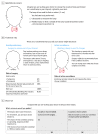The Role of Disease Label in Patient Perceptions and Treatment Decisions in the Setting of Low-Risk Malignant Neoplasms
- PMID: 30896738
- PMCID: PMC6567830
- DOI: 10.1001/jamaoncol.2019.0054
The Role of Disease Label in Patient Perceptions and Treatment Decisions in the Setting of Low-Risk Malignant Neoplasms
Abstract
Importance: The cancer disease label may lead to overtreatment of low-risk malignant neoplasms owing to a patient's emotional response or misunderstanding of prognosis. Decision making should be driven by risks and benefits of treatment and prognosis rather than disease label.
Objective: To determine whether disease label plays a role in patient decision making in the setting of low-risk malignant neoplasms and to determine how the magnitude of the disease-label effect compares with preferences for treatment and prognosis.
Design, setting, and participants: A discrete choice experiment conducted using an online survey of 1314 US residents in which participants indicated their preferences between a series of 2 hypothetical vignettes describing the incidental discovery of a small thyroid lesion. Vignettes varied on 3 attributes: disease label (cancer, tumor, or nodule); treatment (active surveillance or hemithyroidectomy); and risk of progression or recurrence (0%, 1%, 2%, or 5%). The independent associations of each attribute with likelihood of vignette selection was estimated with a Bayesian mixed logit model.
Main outcomes and measures: The preference weight of the cancer disease label was compared with preference weights for other attributes.
Results: In 1068 predominantly healthy respondents (605 women and 463 men) with a median age of 35 years (range, 18-78 years), the cancer disease label played a considerable role in respondent decision making independent of treatment offered and risk of progression or recurrence. Participants accepted a 4-percentage-point increase in risk of progression or recurrence (from 1% to 5%) to avoid labeling their disease as cancer in favor of nodule (marginal rate of substitution [MRS], 1.0; 95% credible interval [CrI], 0.9-1.1). Preference for the nodule label instead of cancer was similar in magnitude to the preference for active surveillance over surgery (MRS, 1.0; 95% CrI, 0.9-1.1).
Conclusions and relevance: Disease label plays a role in patient preference independent of treatment risks or prognosis. Raising the threshold for biopsy or removing the word cancer from the disease label may mitigate patient preference for aggressive treatment of low-risk lesions. Health care professionals should emphasize treatment risks and benefits and natural disease history when supporting treatment decisions for potentially innocuous epithelial malignant neoplasms.
Conflict of interest statement
Figures



Comment in
-
Disease Labels and Clear Communication With Patients-A Rose by Any Other Name Would Smell as Sweet.JAMA Oncol. 2019 Jun 1;5(6):784-785. doi: 10.1001/jamaoncol.2019.0053. JAMA Oncol. 2019. PMID: 30896753 No abstract available.
Similar articles
-
Association of Preferences for Papillary Thyroid Cancer Treatment With Disease Terminology: A Discrete Choice Experiment.JAMA Otolaryngol Head Neck Surg. 2018 Oct 1;144(10):887-896. doi: 10.1001/jamaoto.2018.1694. JAMA Otolaryngol Head Neck Surg. 2018. PMID: 30140909 Free PMC article.
-
Risk of Cancer Recurrence Exerts the Strongest Influence on Choice Between Active Surveillance and Thyroid Surgery as Initial Treatment for Low-Risk Thyroid Cancer: Results of a Discrete Choice Experiment.World J Surg. 2025 May;49(5):1254-1263. doi: 10.1002/wjs.12520. Epub 2025 Mar 5. World J Surg. 2025. PMID: 40044452 Free PMC article.
-
Patient Preferences Around Extent of Surgery in Low-Risk Thyroid Cancer: A Discrete Choice Experiment.Thyroid. 2020 Jul;30(7):1044-1052. doi: 10.1089/thy.2019.0590. Epub 2020 Apr 15. Thyroid. 2020. PMID: 32143553
-
Factors That Inform Individual Decision Making Between Active Surveillance, Hemithyroidectomy and Total Thyroidectomy for Low-Risk Thyroid Cancer: A Scoping Review.Thyroid. 2022 Jul;32(7):807-818. doi: 10.1089/thy.2021.0646. Epub 2022 May 12. Thyroid. 2022. PMID: 35438545
-
Patient Preferences in the Treatment of Hemophilia A: A Best-Worst Scaling Case 3 Analysis.Value Health. 2020 Jul;23(7):862-869. doi: 10.1016/j.jval.2020.02.013. Epub 2020 Jul 21. Value Health. 2020. PMID: 32762987
Cited by
-
Quality of DCIS information on the internet: a content analysis.Breast Cancer Res Treat. 2019 Sep;177(2):295-305. doi: 10.1007/s10549-019-05315-8. Epub 2019 Jun 18. Breast Cancer Res Treat. 2019. PMID: 31214858 Free PMC article. Review.
-
Treatment Choices in Managing Bethesda III and IV Thyroid Nodules: A Canadian Multi-institutional Study.OTO Open. 2021 Jun 24;5(2):2473974X211015937. doi: 10.1177/2473974X211015937. eCollection 2021 Apr-Jun. OTO Open. 2021. PMID: 34250424 Free PMC article.
-
Early Diagnosis of Low-Risk Papillary Thyroid Cancer Results Rather in Overtreatment Than a Better Survival.Front Endocrinol (Lausanne). 2020 Oct 6;11:571421. doi: 10.3389/fendo.2020.571421. eCollection 2020. Front Endocrinol (Lausanne). 2020. PMID: 33123090 Free PMC article. Review.
-
Evaluation of Preference and Utility Measures for Transoral Thyroidectomy.Ann Otol Rhinol Laryngol. 2023 Apr;132(4):381-386. doi: 10.1177/00034894221094950. Epub 2022 May 3. Ann Otol Rhinol Laryngol. 2023. PMID: 35503808 Free PMC article.
-
Pituitary Neoplasm Nomenclature Workshop: Does Adenoma Stand the Test of Time?J Endocr Soc. 2021 Feb 9;5(3):bvaa205. doi: 10.1210/jendso/bvaa205. eCollection 2021 Mar 1. J Endocr Soc. 2021. PMID: 33604494 Free PMC article.
References
-
- Strickland KC, Eszlinger M, Paschke R, et al. . Molecular testing of nodules with a suspicious or malignant cytologic diagnosis in the setting of non-invasive follicular thyroid neoplasm with papillary-like nuclear features (NIFTP). Endocr Pathol. 2018;29(1):68-74. doi:10.1007/s12022-018-9515-x - DOI - PubMed
-
- Howlader N, Noone AM, Krapcho M, et al. , eds. SEER cancer statistics review, 1975-2014, National Cancer Institute. Bethesda, MD, based on November 2016 SEER data submission posted to the SEER website, April 2017. https://seer.cancer.gov/csr/1975_2014/. Accessed January 3, 2018.
-
- Haugen BR, Alexander EK, Bible KC, et al. . 2015 American Thyroid Association management guidelines for adult patients with thyroid nodules and differentiated thyroid cancer: the American Thyroid Association guidelines task force on thyroid nodules and differentiated thyroid cancer. Thyroid. 2016;26(1):1-133. doi:10.1089/thy.2015.0020 - DOI - PMC - PubMed
MeSH terms
LinkOut - more resources
Full Text Sources
Medical

